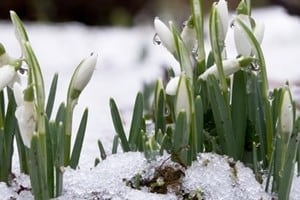
Snow mold forms when snow partially melts but still covers the ground.
Early-spring allergies don't just come from pollinating trees and grasses. They can start up even before the trees have regained their leaves and the grass has started growing again. If you live in an area that got a lot of snow this winter and you're experiencing allergy symptoms earlier than usual, there may be an unexpected culprit: snow mold.
Snow mold makes its home in the pockets of dampness on the ground that occur when accumulated snow begins to melt but still covers the ground. Damp, dead grass covered with snow provides ideal nourishment for the fungus. Once the snow has completely melted, the mold's spores begin to be released into the air, which is what causes allergic reactions in people with mold allergies.
There are two main types of snow mold: gray and pink. Gray snow mold grows mainly on blades of grass, while the pink version attacks the roots and crowns of the plant and takes on a sickly bright pink color as it develops.
To avoid letting snow mold form on your lawn, there are several things you can do this spring. One is to break up any remaining snow banks once the snow starts to melt, allowing them to melt faster and avoiding letting the snow cover the damp ground. If you have to rake up debris from the lawn this spring and you know you have mold allergies, wearing a simple face mask can help you get through the task without triggering allergic symptoms.
If you suffer from allergies in the spring, one of the best things you can do for yourself is invest in a home air purifier. For help finding the best air purifier for allergies, contact US Air Purifiers today.